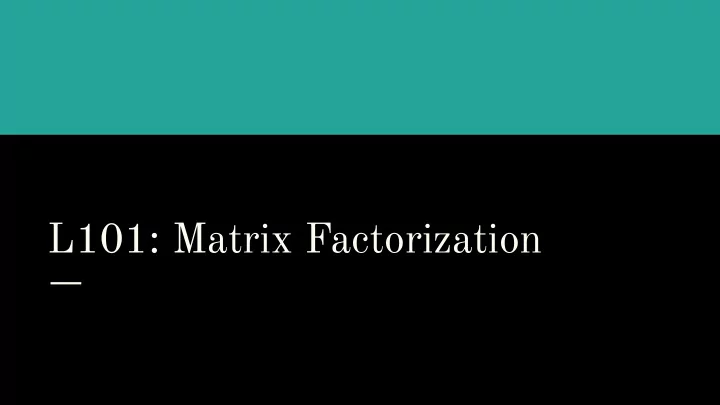

L101: Matrix Factorization
In a nutshell
Matrix factorization/completion you know?
In NLP? ● Word embeddings ● Topic models ● Information extraction ● FastText
Why complete the matrix? Label Features Label Label Label Label f1 f1 f1 f2 f2 f2 f3 f3 f3 f4 f4 f4 f5 f5 f5 f6 f6 f6 1 f1, f2, f3, f4, f6 1 1 1 1 1 1 1 1 1 1 1 1 1 1 1 1 1 1 1 1 f3, f6 1 1 1 1 1 1 1 1 1 1 0 f1, f2, f5 0 1 1 1 0 0 0 1 1 1 1 1 1 0 f1, f2 0 1 1 0 0 0 1 1 1 1 ? f1, f3, f4 ? 1 1 1 ? ? 1 1 1 1 1 1 ? f2 ? 1 ? ? 1 1 1 1 0 0 0 0 1 1 0 0 0 0 Binary classification (transductive) 0 0 1 1 0 0 0 0 1 1 0 0 Semi-supervised Multi-task
Matrix rank The maximum number of linearly independent columns/rows For matrix : ● if N=M=0 then rank( U ) = 0 ● else: max(rank( U ))=min(N,M): full rank
Matrix completion via low rank factorization Given Find , so that Low rank assumption: rank( Y )= L << M,N
Why low rank? Kind of odd: ● low-rank assumption usually does not hold ● reconstruction unlikely to be perfect ● if full-rank then perfect reconstruction is trivial: Y = YI Key insight : original matrix exhibits redundancy and noise, low-rank reconstruction exploits the former to remove the latter
Singular Value Decomposition (SVD) Given We can find orthogonal And diagonal such that
Truncated Singular Value Decomposition If we truncate D to its L largest values, then: is the rank-L minimizer of the squared Frobenius norm:
Truncated SVD … finds the optimal solution for the chosen rank Why look further? ● SVD for large matrices is slow ● SVD for matrices with missing data is undefined ○ Can impute, but this biases the data ○ For many applications, 99% is missing (think Netflix movie recommendations)
Stochastic gradient descent (surprise!) We have an objective to minimize: Let’s focus on the values we know Ω : The gradient steps for each known value:
Word embeddings Jurafsky and Martin (2019) ● SkipGram (Mikolov et al. 2013) MF implicitly ● GloVe (Socher et al. 2014), S-PPMI (Levy and Goldberg, 2014) MF explicitly
Non-negative matrix factorization Given Find , so that ● NMF is essentially an additive mixture/soft clustering model ● Common algorithms are based on (constrained) alternating least squares
Topic models Blei (2011)
Knowledge base population ● Sigmoid function to map reals to binary probabilities ● Combined distant supervision with representation learning ● No negative data, so just sampled negative instances from the unknown values ● Riedel et al. (2013)
Factorization of weight matrices Remember logistic regression: What if we wanted to learn weights for feature interactions? Typically feature interaction observations will be sparse in the training data. Instead of learning each weight in W , let’s learn its low rank factorization: Each vector of V is a feature embedding Can be extended to high-order interactions by factorizing the feature weight tensor
Factorization Machines Paweł Łagodziński ● Proposed by Rendle (2010) ● Can easily incorporate further features, meta-data ● Similar idea was employed for dependency parsing (Lei et al., 2014)
A different weight matrix factorization Remember multiclass logistic regression: For large number of labels with many sparse features, difficult to learn. Factorize! A contains the feature embeddings and B maps them to labels The feature embeddings can be initialized/fixed to word embeddings FastText (Joulin et al., 2017) is the current go to baseline for text classification
Bibliography The tutorial we gave at ACL 2015 from which a lot of the content was reused: http://mirror.aclweb.org/acl2015/tutorials-t5.html ● Tensors ● Collaborative Matrix Factorization Nice tutorial on MF with code: http://nicolas-hug.com/blog/matrix_facto_1 Topic modelling and NMF: https://www.aclweb.org/anthology/D12-1087.pdf Matrix Factorization is commonly used for model compression
Recommend
More recommend